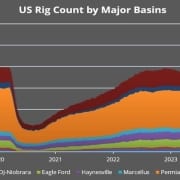A statement from 23-nation the group after an online monitoring meeting on Wednesday didn’t announce any alterations. Led by Saudi Arabia and Russia, OPEC+ plans a series of monthly increases beginning with a 180,000 bpd hike in December — two months later than originally scheduled because of fragile market sentiment.
Oil prices have rallied more than 5% in the past two days after Iran, an OPEC member, launched strikes against Israel in an escalation of the Middle East’s year-long conflict. But at around $75 a barrel, prices remain 14% down from July as traders focus on weak demand in China and swelling supplies from the Americas.
While the retreat offers relief to consumers after years of rampant inflation — and for central banks as they pivot to lowering interest rates — it poses a financial threat to the Organization of Petroleum Exporting Countries and its allies.
Saudi Arabia slashed growth forecasts this week and projected deeper budget deficits than previously estimated as the cost of efforts to overhaul the kingdom’s economy outpaces revenue. Russia, meanwhile, relies on energy income to finance President Vladimir Putin’s war against Ukraine.
JMMC meeting
The JMMC meeting on Wednesday mainly focused on the failure of Iraq, Kazakhstan and Russia. It is for the implementation of their agreed cutbacks, according to delegates who asked not to be identified.
While the countries “reiterated their strong commitment” to the agreement, they mostly continue to pump above their output quotas. They haven’t yet started extra cutbacks pledged as compensation for cheating. The countries held individual workshops to discuss output levels in September.
OPEC+ plans to restore roughly 2.2 MMbpd in monthly tranches between December and late 2025, and allow the United Arab Emirates to make an extra hike in recognition of its increased production capacity.
The alliance has several more weeks to decide whether to go ahead with the December increase. Ministers are scheduled to gather on Dec. 1 to review policy for next year.
With oil markets poised to deteriorate further, analysts including JPMorgan Chase & Co. and Citigroup Inc. have expressed skepticism. It is that OPEC+ will press on with its scheduled supply increases.
Consumption is due to grow by less than 1 MMbpd in 2025. Supplies are set to swell by 50% more. It wil be leaving a glut even if OPEC+ continues to restrain output. This is according to estimates from the International Energy Agency.
Click here to read the full article
Source: Oil & Gas 360
—
Do you have any questions or thoughts about the topic? Feel free to contact us here or leave a comment below.





